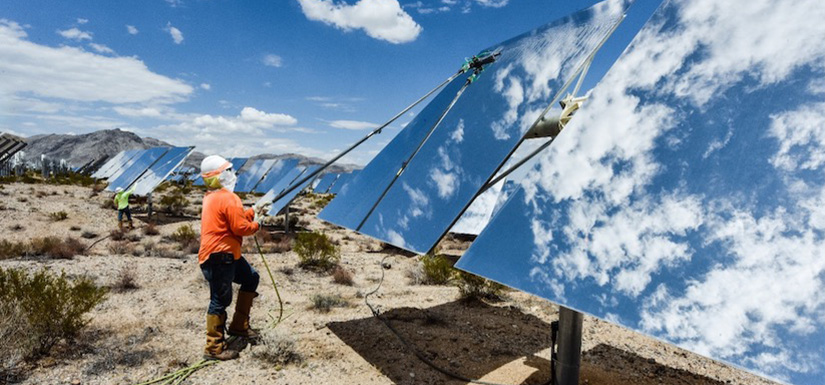Sign up for daily news updates from CleanTechnica on email. Or follow us on Google News!
Successful Projects Will Help Lower Cost of Concentrating Solar-Thermal Power and Support the Next Generation of Highly Trained Workers

Heliostats are large mirrors that track the sun to reflect and direct its rays—and they are critical for efficient, cost-effective concentrating solar-thermal power (CSP) plants. When hundreds or thousands of heliostats work in tandem, they concentrate enough sunlight to produce high temperatures, which CSP plants harness to generate utility-scale electricity or store for later use.
Recognizing the crucial role heliostats play at large-scale CSP facilities, the U.S. Department of Energy’s (DOE’s) Heliostat Consortium (HelioCon) awarded a combined $3 million across six projects to innovate heliostat controls, deployment, and workforce training. Led by universities and industry, the project teams will work closely with DOE’s National Renewable Energy Laboratory (NREL) and Sandia National Laboratories, which co-lead the consortium.
To meet federal electricity cost goals for CSP facilities—5 cents per kilowatt-hour (kWh) for dispatchable CSP configurations or 2 cents/kWh for thermal production—researchers need to realize significant techno-economic improvements for heliostats.
“A heliostat field represents 30%–50% of the direct cost of CSP facilities and a big part of operation and maintenance costs,” said Guangdong Zhu, HelioCon executive director and senior researcher at NREL. “Lowering the cost of heliostats usually means reducing their upfront manufacturing and installation costs or improving their performance and reliability in the field.”
Several of HelioCon’s selected projects (summarized below) have the potential to chip away at heliostat costs through maintenance and control improvements. Several also aim to create new educational programs to prepare the heliostat workforce to bring these and future innovations to industry.
“We’re excited to see that several of these projects address education,” said Margaret Gordon, who co-leads HelioCon and manages the CSP program at Sandia National Laboratories. “Developing support to establish a well-trained and knowledgeable heliostat workforce could reduce costs while at the same time providing economic benefits to local communities.”
Six Projects Receive Funding To Advance Heliostat Performance and Develop the CSP Workforce
Descriptions of the six funded projects are as follows:
Solar Field Control Software
Participating Organizations:
- MarkAyres Engineering (lead)
- Tietronix Software
- Tonopah Solar Energy.
Current control systems for heliostat solar fields lack standardization and reuse among stakeholders who develop central receiver solar power plants. Facility developers create systems from scratch, and there is no major push to share common functions, features, and software libraries due to diverse heliostat, field, and receiver configurations. This increases costs and development timelines for solar field control systems. This project aims to solve this issue by developing an advanced heliostat field control system with multiple modules for various required functions that is adaptable to different heliostat or solar field configurations to reduce costs and enhance performance over today’s technology.
Soiling on Heliostats Estimated by Shaded and Unshaded Scatterometry
Participating Organizations:
- DKA Design (lead)
- Heliogen.
Mirror soiling reduces the energy delivered to concentrating solar power and thermal receivers and requires resource-intensive cleaning, which can abrade mirrors or even break heliostats. This project will develop a centralized, low-labor method to measure the decrease in mirror specular reflectance in a commercial-scale solar field due to soiling and degradation, using imaging data from existing and centralized heliostat control system sensors. If successful, the new technique will eliminate regular, manual in-field mirror measurements. Additionally, the team may increase mirror soiling data density, frequency, and accuracy to support control system fidelity and optimize cleaning schedules.
A Brighter Future: Education and Outreach for Small-Scale Concentrating Solar on Urban Brownfields
Participating Organizations:
- Rice University (lead)
- Harris County
- Community Lattice
- Kinder Institute for Urban Research.
This project will uncover and address the root cause of gaps in educational training opportunities in concentrating solar thermal (CST) technologies, with an emphasis on community integration. While four-year institutions offer scattered undergraduate- and graduate-level classes that touch on CST, many only include a brief overview or emphasize photovoltaics over CST in solar-focused units or courses. Where CST topics are included, presentations tend to be highly and exclusively technical, which oversimplifies the economic and sociological elements of both the applications and site selection that are crucial to expanding CST implementation. To that end, this project will develop generalizable insights and a publicly available toolkit that two- and four-year institutions can use to create a sustainable community of future CST researchers, innovators, and practitioners.
PROMETHEUS: Predictive and Optimized Control of Heliostats for Future Solar Fields
Participating Organizations:
- University of Wisconsin-Madison (Lead)
- Queensland University of Technology
- Politecnico di Milano.
The PROMETHEUS project aims to develop an innovative tool to improve real-time heliostat control and aiming in the solar field. The tool will optimize the aiming strategies accounting for the impact of flux intensity on receiver lifetime; the actual status of the heliostats (i.e., soiling distribution, broken mirrors, drivers); and required driver power consumption during transient operation. Ultimately, the tool will lead to better control of heat flux on receivers, reducing their degradation and risk of failure.
Precision Angle Measurement System for Enhanced Heliostat Performance and Cost Reduction
Participating Organizations:
- University of Nevada, Las Vegas (lead)
- BriteSource Technologies.
This project aims to improve the annual performance of heliostat fields through the development of a cutting-edge measurement instrument called the Operating Surface Angle Measurement System (OSAMS). OSAMS is designed to enhance the accuracy and efficiency of heliostat design, prototyping, and field performance evaluation by enabling precise measurement of various parameters that affect the accuracy of heliostat reflective beams. By synchronizing measurements from sensors to heliostat tracking algorithms, OSAMS provides insights into relative surface normal differences across the system. In this way, it can facilitate the detection of changes in reflective angles under typical operating conditions, including the effects of gravity, thermal dynamics, and wind deflection.
Advancing University Level Education on Heliostat Design and Operation
Participating Organizations:
- Northeastern University (lead).
This project aims to develop educational, research, and student outreach opportunities in heliostat and CSP technology. Using targeted classroom instruction and undergraduate-level research projects, the project team will incorporate heliostat education into course syllabi and homework assignments on concentrating solar energy—ultimately making it a part of Northeastern University’s engineering curriculum.
Learn more about HelioCon, which is funded by DOE’s Solar Energy Technologies Office.
By Erik F. Ringle. Courtesy of NREL.
Have a tip for CleanTechnica? Want to advertise? Want to suggest a guest for our CleanTech Talk podcast? Contact us here.
Latest CleanTechnica.TV Videos
CleanTechnica uses affiliate links. See our policy here.
CleanTechnica’s Comment Policy




